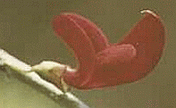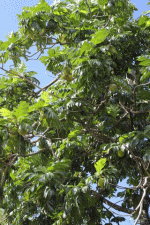
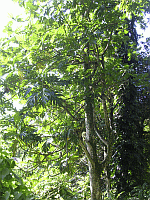

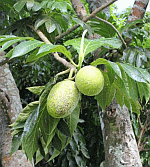
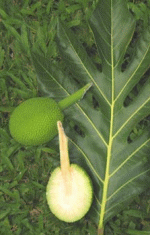
|
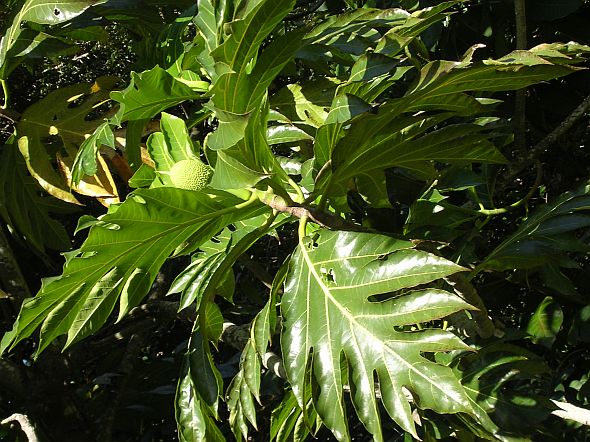
Davison Shillingford
Plant Family: Tree of the famed "Mutiny on the Bounty" saga; belongs to the Moraceae family, which includes the Banyan Tree (Ficus benghalensis), Fije of the Dominica forests (F. citrifolia), and the common Fig of commerce (F. carica).
Description: One of the most handsome trees of the Tropics; is widely cultivated in Dominica; Gardens specimen is short distance south of Fish Pond; evergreen trees with milky sap, single stemmed, up to 20 m or more (62 ft); leaves up to 100 cm long (39 in) and 62 cm broad (24 in), with prominent pinnate lobes 8-23 cm long (3-9 in), a striking dark, shinny green on upper surface, lighter green below; flowers unisexual on same tree; male a light yellow catkin, 15-30 cm long (6-12 in), females born in tightly packed, prickly clusters which ultimately form the fleshy compound fruit; fruit light green, globose to ovoid and seedless, 15-23 cm long (6-9 in) and 12-18 cm in diameter (4.6-7.0 in), reportedly weighing 2-10 pounds, skin of young fruit with pyramidal projections; flesh firm and white or yellowish; 1-3 fruit at tip of branch; main crop from January to August with some fruiting the rest of the year; many varieties exist, with 31 reported in Tahiti.
Natural Habitat: Moderately rainy, moist areas of Tropics, from sea level to 1500 ft; propagated by cuttings and suckers.
Origin and Distribution: Native to Southeast Asia; especially common in South Pacific islands; is now distributed throughout the Caribbean and tropical America, and has been widely introduced elsewhere in the Tropics.
Uses: Cultivated primarily for its fruit which is as versatile as the Irish potato; it is usually eaten when mature, but before ripening, and is boiled, baked, roasted, mashed or fried; has smooth texture and mildly nutty flavor, with some varieties slightly sweet; the ripe fruit is soft and sweet and can be used in deserts; medicinally, leaf infusion used to treat certain types of heart disease; leaves also used for hypertension, diabetes, diarrhea and urinary tract infections; stem exudate used for abscesses, bruises and sprains.
Indigenous Legends: Brought to Caribbean by Captain Bligh in 1793 to feed plantation slaves; a tree in the St. Vincent Botanic Gardens is claimed to have been grown from a sucker of one of Captain Bligh’s original trees.
References:
Robert A. DeFilipps. Useful Plants of the Commonwealth of Dominica, West Indies. Smithsonian Institution, Washington, D.C. 1998
Anon. [Joseph Jones?]. Official Guide to the Botanic Gardens, Dominica. Kew Gardens, London 1924?
Dorothy P. Storer. Familiar Trees and Cultivated Plants of Jamaica. Macmillan, London 1964
J. B. Bourne, G.W. Lennox and S.A. Seddon. Fruits and Vegetables of the Caribbean. Macmillan, London 1988
William C. Kennard and Harold F. Winters. Some Fruits and Nuts for the Tropics. USDA, Washington, DC 1960
C.D. Adams. Flowering Plants of Jamaica. University of the West Indies, Mona, Glasgow University Press 1972
H.F. Macmillan. Tropical Planting and Gardening. Macmillan, London 1956
Dan H. Nicolson. Flora of Dominica, Part 2: Dicotyledoneae. Smithsonian Institution, Washington, D.C. 1991
Robert A. DeFilipps, et al. Medicinal Plants of the Guianas. Smithsonian Institution, Washington, D.C., draft, downloaded January 2007 (www.mnh.si.edu)
|

